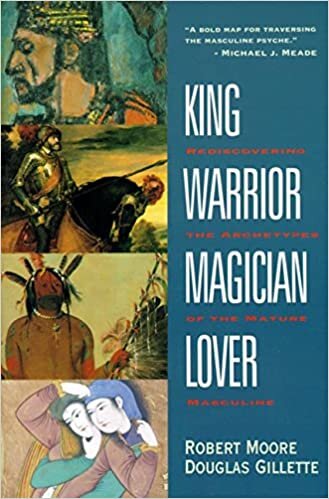King, Warrior, Magician, Lover Book Review

by Robert Moore and Douglas Gillette
$9.95; 160 pages
Based on a recommendation from the Art of Manliness, I bought King, Warrior, Magician, Lover: Rediscovering the Archetypes of the Mature Masculine from Bookmans. I couldn't find it at my local new bookstores, but you can find it online new or used. Since I bought it used, it took me forever to find the tiny "Men's issues" section. It was only one shelf in a rather large bookstore, but I finally found it tucked underneath the sexual self-help books. It was worth the effort.
The four archetypes show their power from the first. These are not alien ideas forced onto us. Rather, they are us, in a more pure form. The archetypes help us to see what is best in ourselves, as men. The King is the source of order, he is wise and just. The Warrior has boundless energy. He is devoted to a cause greater than himself, and fiercely loyal. The Magician is powerful and crafty, and he has the ability to detach himself from events and see more clearly. The Lover seeks beauty in all its forms, and delights in it. He can break down barriers and empathize with everyone.
This book is valuable for anyone who wants to know what it is to be a man. It is also valuable if you are interested in understanding depictions of masculinity, both positive and negative. I can easily think of people I know, or situations I have found myself in, and immediately see the application of these archetypes of masculinity.
Moore and Gillette are definitely children of their age: the Age of Aquarius. With that in mind, I found the chapter on the Lover the most unbalanced. This is the chapter that is the least burdened with scholarship or historical accuracy. It is also the least aware of the negative side of the archetype. The chapter on the King went into great depth on the bipolar shadow Kings, the Tyrant, and the Weakling. The chapter on the Lover talked about the Addicted Lover and the Impotent Lover, but many of the examples used for the Lover per se were really just as bad as the shadow forms. Given that the Lover is the spirit of the age, it is probably hard to attain critical distance.
I see an interesting parallel between Moore and Gilette's four archetypes and the DiSC model created by William Marston. Each one of the four archetypes has a strong relationship to one of Marston's four mental energies. The King is similar to the Steadfast/Submissive energy. This would have been hard to see, except that the woman who taught me about DiSC mentioned that many Fortune 500 companies have CEOs with S personalities. Under the DiSC system, the Dominant type seems like the natural leader. Driven to succeed, quick to think, quick to work, charismatic. Yet, the D energy can be very harsh and unyielding. This is because it is really like the Warrior.
I think the confusion arises from the name. When we in the Anglosphere think of a King, we think especially of the English kings, men like Richard the Lionhearted or Henry VIII, who had big ideas and big appetites, bundles of energy that got whatever they wanted. However, what we are really talking about here is no mere king, but the Emperor. The Emperor is the still center, the source of order who quells rebellion by the rumor of his imperturbability. Except in the direst of emergencies, the Emperor does not take the field of battle himself.
The Lover is like the Influencer. Always talking, focused on relationships, a great love of life, unconcerned about details. The Magician is the Conscientious type. Hardworking, knowledgable, focused on facts and results, quiet and reserved.
One needn't look too far to find things that don't match either. The DiSC model attributes empathy especially to the S, while KWML attributes this to the Lover. Nonetheless, the convergence is striking. I am always interested when two separate lines of thought arrive at the same result. I look forward to reading what Brett on the Art of Manliness posts about this book in the future. This is a topic worth revisiting.

Comments ()